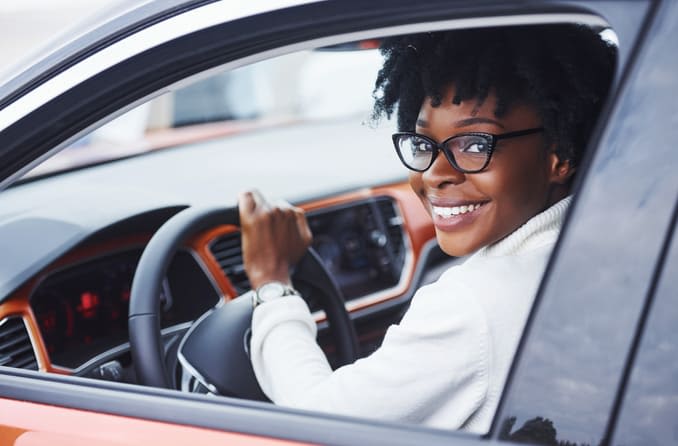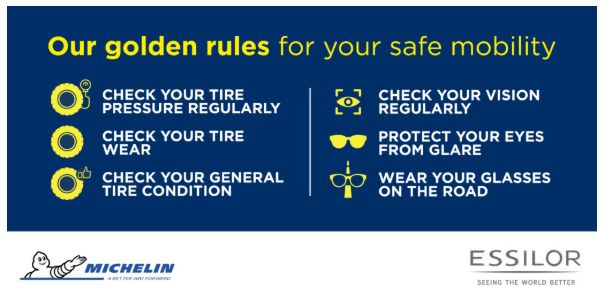The importance of healthy vision for road safety

Reading road signs at a distance enables you to get off the highway at the correct exit. Seeing the dials your dashboard can keep you from running out of gas or hearing a siren approach from behind because you were speeding.
Being able to see clearly is so important to road safety — your own and any family members or friends riding with you, as well as everyone else in vehicles approaching, beside, in front and behind you on the road.
That’s why Essilor (the world’s leading ophthalmic optics company and owner of All About Vision) is partnering with the United Nations to raise awareness about the importance of clear vision to reduce accidents and fatalities on streets and highways.
In the context of recovered mobility, after the worldwide lockdown to curb the spread of coronavirus, Essilor and Michelin (the global tire and sustainable mobility leader) have launched a common awareness campaign, “Together for safe mobility: Check your vision, Check your tires."
Vision and road safety by the numbers
Before you get behind the wheel, consider these statistics:
90%: Up to 90% of the information needed to make safe decisions on the road comes through our eyes.
20%: One in five drivers cannot see clearly, despite the fact that 80% of vision impairments can be prevented or treated.
3 seconds: Driving only 30 mph with uncorrected vision can require an extra 3 seconds to recognize and read road signs. If you can't read road signs quickly, how will you react when a child darts into the road in front of your car?
3,700: Road-related accidents are the leading cause of death for young people, taking an average of 3,700 lives every day.
2X-4X: Fatal car accidents are two to four times more likely to occur at night, but night vision can be improved simply by wearing corrective eyeglasses with a reflective coating.
2.5X: Drivers with unaddressed cataracts are two and a half times more likely to be involved in an accident, and drivers over the age of 40 with presbyopia have difficulty seeing clearly up close without correction.
How vision plays a role in road safety
When you get behind the wheel, your vision, particularly the following aspects of your eyesight, are what will help you get where you're going safely:
Clarity
Blurred vision may be caused by cataracts or refractive errors such as myopia (nearsightedness), hyperopia (farsightedness), presbyopia or astigmatism. Glasses, contact lenses and vision surgery can correct for all of these.
Binocular vision and depth perception
To be "road safe," an adequate judgment of space and distance is crucial. Binocular, or 3D vision, may be impaired when there is a squint present or when both eyes have a vastly different prescription.
Night vision
Poor vision in low-light conditions can severely hamper safe driving. Low-light and night driving are two very obvious examples where we need our vision to be sharp. Car headlights, for example, are the main cause of visual discomfort at night. Anti-glare lens coatings can help reduce the glare of headlights.
Visual field
To drive safely, you need a clear horizontal visual field across a visual field of 120 degrees with no significant defect within the central 20 degrees from fixation (i.e when you’re directly looking at a target in question) .
Damage to your visual field can be caused by a number of different conditions. For example, blind spots or tunnel vision resulting from glaucoma, retinal detachment or optic neuropathy can severely interfere with a person’s ability to drive safely on the road.
Glare
Dazzle from sunlight or glare while traveling at night can temporarily blind you to other cars and lane markers on the road. The effects of glare can be compounded by cataracts, corneal scars or glaucoma.
Solutions? Anti-glare coatings and sunglasses will dial down the glare from the sun, and your anti-glare coating will help you dim overly bright lights at night.
How can you ensure optimal vision and road safety?
Taking these few steps will ensure your vision is top flight before you hit the road again:
Get regular eye exams
Seeing an eye doctor regularly helps identify and treat any vision conditions. For example, around age 40, you will start to experience presbyopia, or age-related farsightedness, and progressive lenses can enable you to see near, far and in-between again.
With regular eye exams — it's recommended that you sign up for a comprehensive eye examination at least once in two years to monitor any changes in vision — your vision prescription is always current, too.
WHEN WAS YOUR LAST EYE EXAM? Find an eye doctor near you and book an exam.
Get the right pair of glasses
Most visual concerns stemming from either environmental factors or eye conditions can be overcome with the right pair of glasses.
Driving a lot into the sun in the morning or evening? Anti-glare lenses are a must.
Tired of reaching in your glove box (and taking your eye off the road) to switch to your sunglasses? Keep your eyes on the road with photochromic, also called transition lenses.
Photochromic lenses are like two glasses in one — prescription glasses to help you see clearly that darken in bright sunlight to protect your eyes from the sun's harmful rays.
Keep your windshield and glasses clean
Seeing clearly behind the wheel starts with cleaning your windshield. Once you have that big piece of glass clean, make sure your glasses lenses are clear of dust particles, smudges and stains.

Essilor and Michelin partner for safe mobility
As two major actors of safe mobility and partners of the United Nations. Essilor and Michelin have launched a common awareness campaign “Together for safe mobility: Check your vision, check your tires.” This campaign urges drivers to check their vision and their tires before getting on the road again.
For example, nearly 50% of cars being driven have underinflated tires, and 1 in 10 cars has over-worn tires. Driving under these circumstances is extremely dangerous and can easily result in popped or blown-out tires and accidents.
One the road again ... and traveling in safety
In recent months, you — like much of the world's population — likely have been staying close to home to help reduce the spread of the new coronavirus.
As lockdowns ease and business returns, you and millions of others will be hitting the road again heading back to work and shopping and traveling.
Eye care practices that closed temporarily are reopening, meaning you can get eye exams (with enhanced safety protocols) and eyeglasses so you will be able to see clearly when you get behind the wheel.
In that context, Essilor launched the campaign titled “On the Road again,” using the hashtag #MaxVisionMaxSafety. It encourages drivers, cyclists, pedestrians and the like to return to the roadways with a newfound appreciation for restored mobility, a reliable mode of transportation and safe, clear vision.
FIND AN EYE DOCTOR NEAR YOU: Get your eyes examined and new glasses or sunglasses so you can hit the road safely.
Page published on Monday, June 15, 2020






